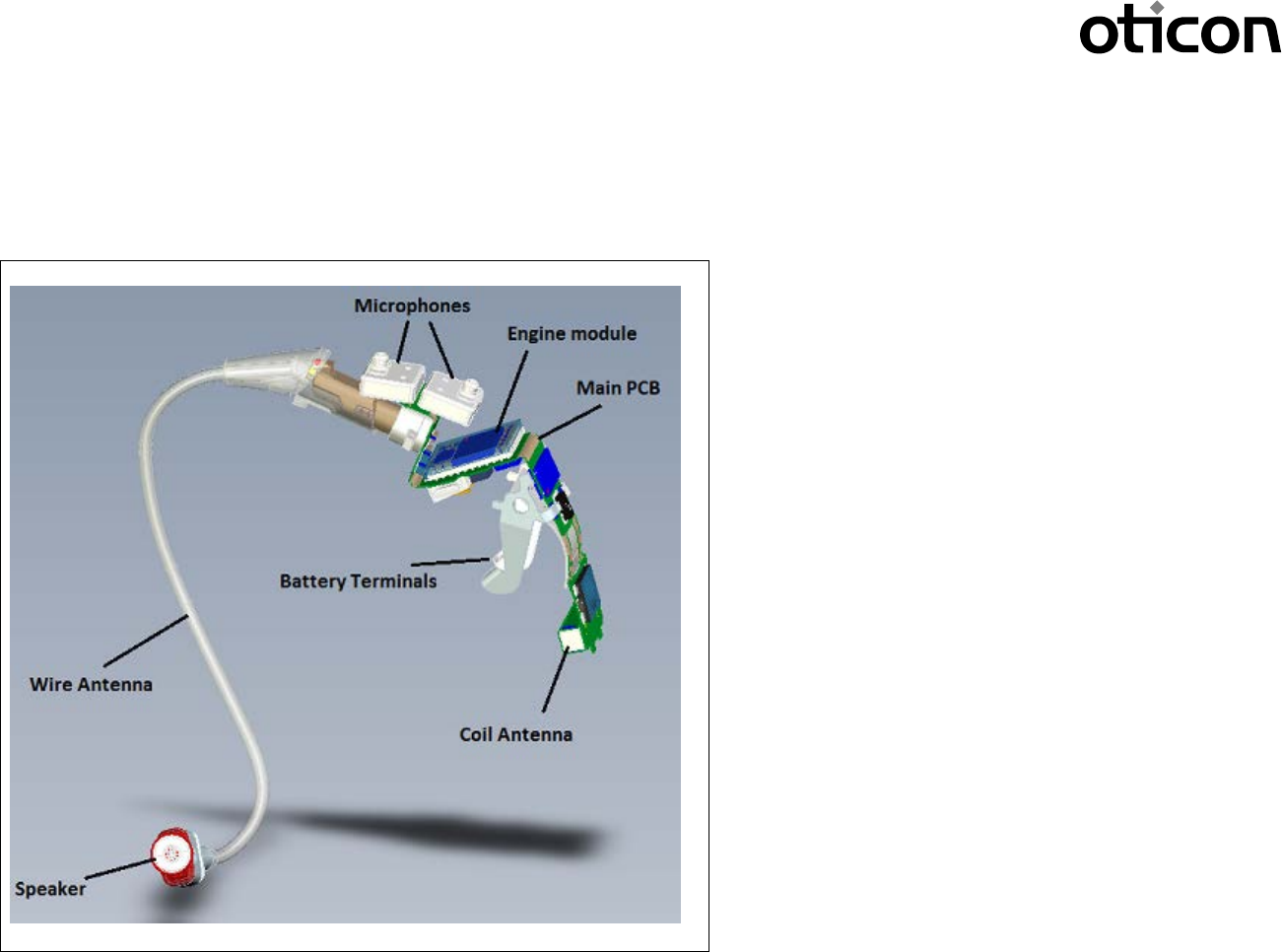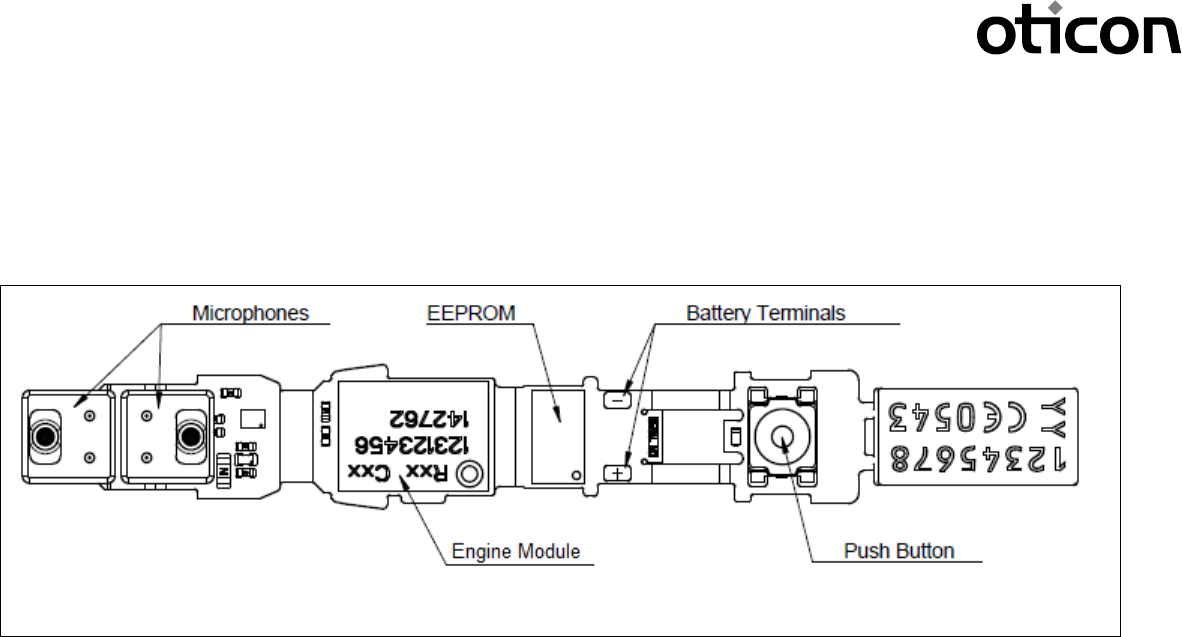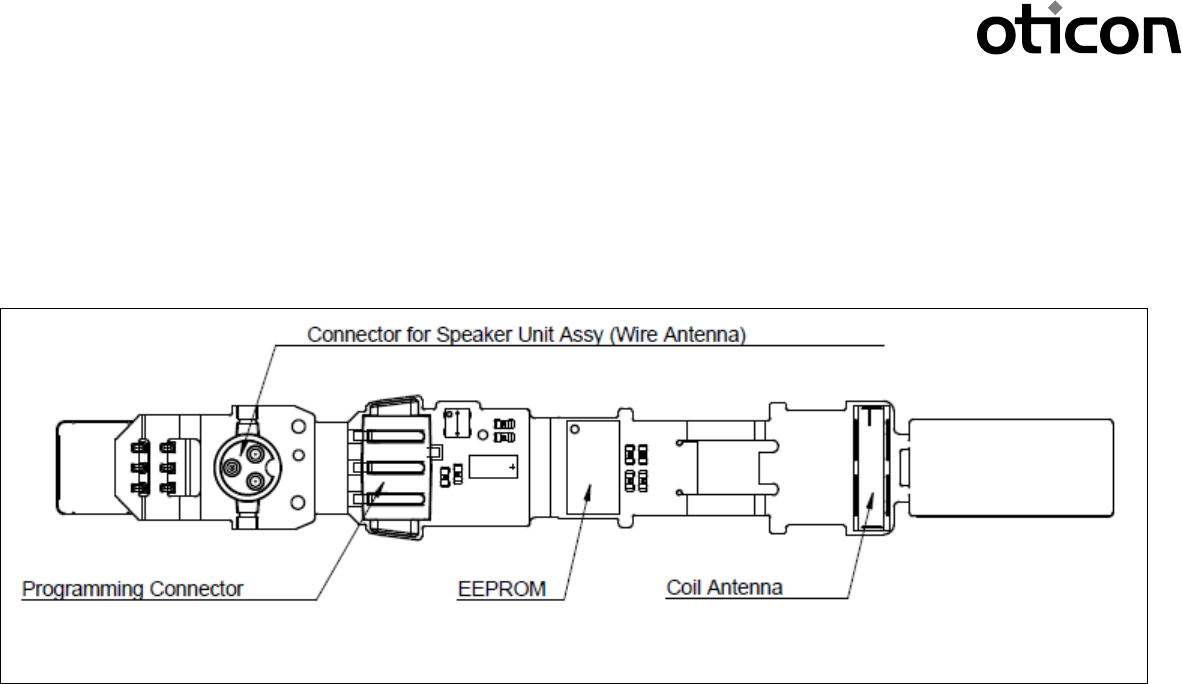Oticon A S AUMRIT Oticon Opn mini RITE wireless hearing aid with Aurora mini RITE radio module. User Manual COMPANY LETTER HEAD
Oticon A/S Oticon Opn mini RITE wireless hearing aid with Aurora mini RITE radio module. COMPANY LETTER HEAD
Contents
- 1. InstallationInstructions
- 2. installation guide
InstallationInstructions

PEOPLE FIRST
Oticon A/S Kongebakken 9 DK-2765 Smørum www.oticon.com
Main +45 39 17 71 00 Fax +45 39 27 79 00 Denmark CVR-no. 42334219 1
Oticon Radio Model - Quick Installation Guide
Radio Model Name: Aurora mini RITE
The Aurora mini RITE radio model contains two radio transceivers running at 3.84 MHz and 2.4 GHz and both implemented on a single hardware platform.
The radio model is implemented in an engine module mounted on the
main PCB with connections to the antennas, the microphones, the speaker
and the battery terminals. The radio model can be seen in 3D overview to
the left:
The 3.84 MHz radio is a low power, short range, inductive radio
transceiver working at a single channel at 3.84 MHz using MSK
modulation with 320 kbit/s data rate and connected to a small coil
antenna. The 2.4 GHz radio is a Bluetooth Low Energy (BLE)
transceiver using GFSK modulation with 1 Mbit/s data rate also capable
of proprietary modes with higher data rates and connected to a short wire
antenna.
Aurora mini RITE Radio Model – 3D overview

PEOPLE FIRST
Oticon A/S Kongebakken 9 DK-2765 Smørum www.oticon.com
Main +45 39 17 71 00 Fax +45 39 27 79 00 Denmark CVR-no. 42334219 2
Oticon Radio Model - Quick Installation Guide
Radio Model Name: Aurora mini RITE
Below the main flex PCB of the Aurora mini RITE radio model with the most important electrical and electro-mechanical components can be seen:
Aurora mini RITE Radio Model – Main PCB – Top side
The most important part of the radio model is the Engine Module mounted on the main flex PCB, which connects it to both the EEPROM memory and all external
connections: On the top side these are the microphones, the battery terminals and the push button.
The Aurora mini RITE radio model requires only a single cell battery and an external speaker (also incl. the wire antenna for the Bluetooth radio part) to be
attached and plastic shells, defining the industrial design of a hearing aid end product and holding everything together, in order to be operational.

PEOPLE FIRST
Oticon A/S Kongebakken 9 DK-2765 Smørum www.oticon.com
Main +45 39 17 71 00 Fax +45 39 27 79 00 Denmark CVR-no. 42334219 3
Oticon Radio Model - Quick Installation Guide
Radio Model Name: Aurora mini RITE
On the bottom side of the main PCB of the Aurora mini RITE radio model the connector for the speaker unit assembly (where the wire antenna for the Bluetooth
radio is an integrated part), the programming connector, EEPROM memory and coil antenna for the 3.84 MHz radio can be seen:
Aurora mini RITE Radio Model – Main PCB – Bottom side
The most important parts inside the Engine module are a Digital-Signal-Processor (DSP), a radio Front-End (FE) chip for the 3.84 MHz radio part and an RF chip
for the Bluetooth radio part – all mounted on a small rigid PCB again mounted on the main flex PCB. The Aurora mini RITE radio model also includes all voltage
regulators and buffered data programming inputs on board. The DSP is the main processor controlling the functionality of both radios in the Aurora mini RITE
radio model.
The Aurora mini RITE radio model is intended to be installed in Oticon, Bernafon, Sonic and affiliated wireless hearing aid devices of the mini RITE (Reciever-In-
The-Ear) wearing style.

PEOPLE FIRST
Oticon A/S Kongebakken 9 DK-2765 Smørum www.oticon.com
Main +45 39 17 71 00 Fax +45 39 27 79 00 Denmark CVR-no. 42334219 4
Oticon Radio Model - Regulatory Label Information
Radio Model Name: Aurora mini RITE
Contains: FCC ID: U28AUMRIT
IC: 1350B-AUMRIT
NOTICE:
This device complies with Part 15 of the FCC Rules and with RSS-210 and RSS-247 of Industry Canada.
Operation is subject to the following two conditions:
(1) This device may not cause harmful interference, and
(2) This device must accept any interference received, including
interference that may cause undesired operation.
Changes or modifications made to this equipment not expressly approved by Oticon A/S may void the FCC authorization to operate this equipment.
Le présent appareil est conforme aux CNR d'Industrie Canada applicables aux appareils radio exempts de licence.
L'exploitation est autorisée aux deux conditions suivantes:
(1) l'appareil ne doit pas produire de brouillage, et
(2) l'utilisateur de l'appareil doit accepter tout brouillage radioélectrique subi, même si le brouillage est susceptible d'en
compromettre le fonctionnement.